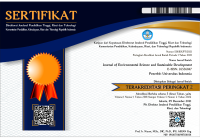Abstract
Decoupling resource use efficiency and ecological impacts are two challenges of oil palm smallholders in Indonesia. This study aims to find option for increasing productivity among smallholder and to reduce the environmental impacts of nutrient management in their plantations. We adopted UNEP’s definition of resource and impact decoupling as a tool to estimate resource decoupling rate and impact decoupling rate. The average smallholder’s resource decoupling rate from 2013 to 2017 is 0.86 kg fertilizer/kg fresh fruit bunch. This rate is 93.48% of the average of the companies (0.92 kg fertilizer/kg fresh fruit bunch) for the same period. Reducing the fertilizers dosages will reduce the resource decoupling rate and the impact decoupling rate by 58.14% (from 0.86 to 0.36 kg fertilizer/kg fresh fruit bunch) and by 67.32% (from 3.06 to 1.10 g CO2e/kg fresh fruit bunch) respectively. Reducing the fertilizer dosage is the most appropriate approach to increasing the resource and impact decoupling rates. We conclude that a smallholder is able to produce fresh fruit bunches sustainably by changing nutrient management practices and increasing access to certified planting material. Further study is required to include the influence of land use change on the impact decoupling rate as this factor was not included in our analysis.
Recommended Citation
Suratin, Aloysius; Karuniasa, Mahawan; and Utomo, Suyud Warno
(2018).
IS SUSTAINABLE OIL PALM PRODUCTION POSSIBLE FOR SMALLHOLDERS?.
Journal of Environmental Science and Sustainable Development, 1(1), 25-39.
Available at: https://doi.org/10.7454/jessd.v1i1.16






